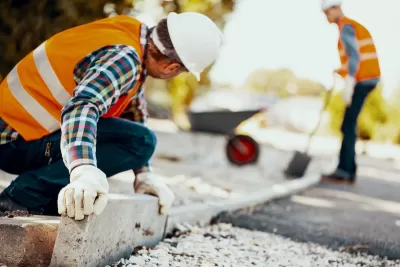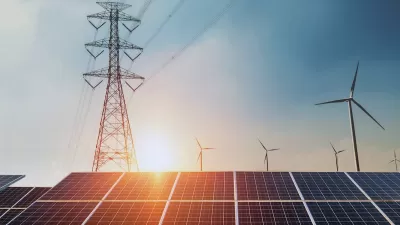How sustainable investments in infrastructure made today can secure the future.

What’s worse than a midlife crisis? An old age crisis — which is where the bulk of U.S. infrastructure is today. The United States made major infrastructure investments 80 to 100 years ago, then steadily disinvested in maintenance while adding more users that, in some cases, disproportionately impacted the infrastructure. Now, we’re witnessing the effects of both climate and man-made stressors.
Establishing benchmarks for progress
You can’t manage what you can’t measure, so there needed to be an analytic tool to track progress — or the lack thereof. To that end, the American Society of Civil Engineers (ASCE) began issuing a Report Card for America’s Infrastructure in 1998.Every four years, a committee of professional experts convenes to develop a comprehensive assessment of the nation’s 17 major infrastructure categories, based on publicly available data. The information is assessed, and the committee consults with industry experts and assigns grades based on the following criteria:
Capacity: Does the infrastructure capacity meet current and future demands?
Condition: What is the infrastructure’s existing and near future physical condition?
Funding: What is the current level of funding from all levels of government for the infrastructure category as compared to the estimated funding need?
Future Need: What is the cost to improve the infrastructure? Will future funding prospects address the need?
Operations and Maintenance: What is the owner’s ability to operate and maintain the infrastructure properly? Is the infrastructure in compliance with government regulations?
Public Safety: To what extent is the public’s safety jeopardized by the condition of the infrastructure and what could be the consequences of failure?
Resilience: What is the infrastructure system’s capability to prevent or protect against significant multi-hazard threats and incidents? How is it able to recover quickly and reconstitute critical services with minimum consequences for public safety and health, the economy, and national security?
Innovation: What new and innovative techniques, materials, technologies, and delivery methods are being implemented to improve the infrastructure?
In the 2021 Report Card, America’s infrastructure finally climbed out of a cumulative average in the D range to a C-. While an improvement, it’s nothing to be proud of.
The Report Card has been an asset for heightening the recognition of our nation’s infrastructure needs with both elected officials and the media and is now a powerful tool to help us track trends.
The focus on these grades resulted in state, local, and tribal governments making more investments, followed by record-making funding levels through the Bipartisan Infrastructure Law (BIL), the CHIPS and Science Act, the Inflation Reduction Act, and many other small authorization bills. Appropriations through the end of federal fiscal year 2024 have been higher than ever, and we are starting to see the results in the number of projects underway. Once all this work is completed in the coming years, we will see an uptick in the scores.
Building resilience for an unpredictable future
With all the current stressors on our infrastructure like climate change, man-made disasters, and negligent upkeep, there has never been a greater need to focus on the sustainability and resilience of projects and programs. Not only is it better for our planet and environment, but it makes economic sense. We do not have large pots of money to keep rebuilding the same vulnerable infrastructure in the same places with more frequent stressors. I suggest we change the narrative to enforce the business case for resilient infrastructure.
In a project’s lifecycle, there are usually three components in chronological order: the financial cycle, the design cycle, and the useful life cycle.
In the 1800s, we built massive infrastructure like the Brooklyn Bridge. Since its state-of-the-art design was not well established at the time, we used the adage, “When in doubt, make it stout.” With regular maintenance, such ‘old’ infrastructure can perform well today even though it was not designed for the level of repetitive loading it now sees, including climate stress. As the technology of design matured, there was a commensurate drop in the safety factors to cut down the construction cost of the asset. When additional stress is added, the asset deteriorates on an accelerated basis. One example is the old Tappan Zee Bridge in New York. Built after the Korean War, the amount of steel was reduced to the point that it needed replacement almost within its design life.
Now is the right time to make bold investments
With all the major climate events over the past decade, we are seeing many major assets not reaching their financial life cycle, making municipal bonding much less of a sure investment. This all comes at the wrong time considering current needs. To meet them, owners will need to utilize every tool in the toolbox to make the necessary investments in resilient infrastructure.
Because many contractors and concessionaires have seen billion-dollar losses over the past few years, there is a growing consensus that we need to do things differently. As we work to develop national building standards, coupled with sustainability and resilience codes such as the Standard Practice for Sustainable Infrastructure ASCE 73-23, and the ASCE MOP 140-2018 Climate Resilient Infrastructure, we will see a stronger baseline for building infrastructure.
Public sector owners of infrastructure facilities and structures are usually interested in driving capital investment costs down, followed by minimizing asset maintenance. This is a risky strategy. Because of the large backlog of unfunded projects, they and their financial advisors fear increasing upfront capital costs. If the infrastructure capital financiers would acknowledge a standard as a risk management tool, they might consider lowering the cost of money. If that discount is 100 index points, this is enough to pay for the additional investment in resilience upfront. That is what I call “Magic Money.” The owner gets a better asset without additional costs, due to the discounted rate, and the borrower gets a better risk profile that the asset will perform well over the financial life.
In July, GHD released a report titled “CROSSROADS” that presents a comprehensive understanding of intergeneration equity through an infrastructure lens. Globally, 13,000 people were surveyed, including 4,000 in the United States. Crossroads brings diverse, multigenerational voices to help lead us to better decision-making when it comes to infrastructure decisions for the next 50 years. The $1.2 trillion BIL supporting more durable and sustainable infrastructure signals the beginning of reinvestment that hasn’t been enacted since World War II. We want to make sure that this work is designed in a way that meets current and future needs for both the useful and financial life of the improved asset.
As societal needs evolve, the resilience and adaptability of infrastructure become vital in mitigating the impacts of climate change, population growth, and economic fluctuations. The information presented in CROSSROADS can serve as a benchmark, incorporating perspectives from multiple generations to ensure infrastructure is adaptable to evolving societal demands and environmental challenges. Our future generations deserve our thoughtful approach.
Maria Lehman, P.E., F.ASCE, ENV SP, is U.S. Infrastructure Lead for GHD. She is also the past president of the ASCE and currently serves as vice chair of President Biden’s National Infrastructure Advisory Council.

Alabama: Trump Terminates Settlements for Black Communities Harmed By Raw Sewage
Trump deemed the landmark civil rights agreement “illegal DEI and environmental justice policy.”

Planetizen Federal Action Tracker
A weekly monitor of how Trump’s orders and actions are impacting planners and planning in America.

The 120 Year Old Tiny Home Villages That Sheltered San Francisco’s Earthquake Refugees
More than a century ago, San Francisco mobilized to house thousands of residents displaced by the 1906 earthquake. Could their strategy offer a model for the present?

Opinion: California’s SB 79 Would Improve Housing Affordability and Transit Access
A proposed bill would legalize transit-oriented development statewide.

Record Temperatures Prompt Push for Environmental Justice Bills
Nevada legislators are proposing laws that would mandate heat mitigation measures to protect residents from the impacts of extreme heat.

Downtown Pittsburgh Set to Gain 1,300 New Housing Units
Pittsburgh’s office buildings, many of which date back to the early 20th century, are prime candidates for conversion to housing.
Urban Design for Planners 1: Software Tools
This six-course series explores essential urban design concepts using open source software and equips planners with the tools they need to participate fully in the urban design process.
Planning for Universal Design
Learn the tools for implementing Universal Design in planning regulations.
Clanton & Associates, Inc.
Jessamine County Fiscal Court
Institute for Housing and Urban Development Studies (IHS)
City of Grandview
Harvard GSD Executive Education
Toledo-Lucas County Plan Commissions
Salt Lake City
NYU Wagner Graduate School of Public Service






























